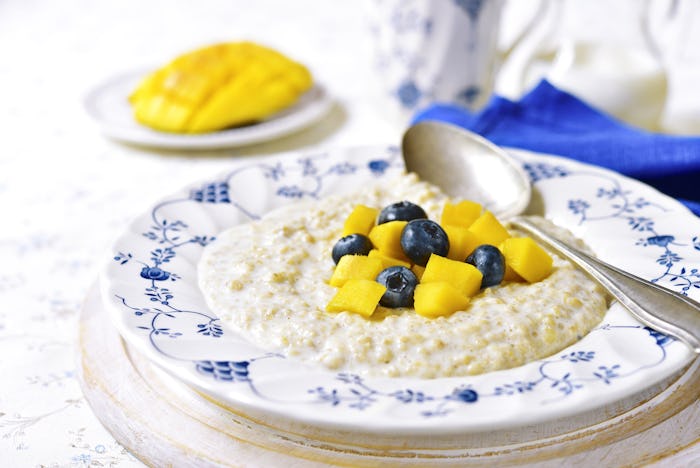Is your baby able to sit up without support? Have they developed a "pincer" grasp and can pick up objects between their forefinger and thumb? Experts will tell you that these are the signs that show your baby is ready for solids — usually around 6 months old. But beyond the jars of baby food, what kind of snacks should a 6-month-old eat? Do they even need snacks?
Resident dietitian at Yummy Spoonfuls, Anita Mirchandani, tells Romper that first snack options depend on your child and feeding strategy, but some good options are 1 to 2 tablespoons of millet-style oatmeal, or a thick "superfood" smoothie, 1 to 2 teething biscuits (that dissolve in their mouth), or even a small slice of a ripe pear, a soft ground meat patty made smooth by food processing, or an ounce of tofu. "If a child is prone to reflux, neutral foods and snacks would be recommended, such as carb-based snacks," she says.
Certified health coach Michelle Beckner, who also works with moms of infants, insists that the best snack for a 6-month-old isn't anything solid — it's breast milk or formula. "[For a 6-month-old] solid food is simply for them to start experimenting with new tastes and textures, and get familiar with the idea that food satisfies their hunger the same as a bottle or breast," she tells Romper in an email interview. "Some of the best first foods are whole, unprocessed foods such as vegetables, fruits, and meats, and as long as the food is soft enough to squish between your fingers, and sized appropriately, they should be able to eat it. Or, of course, whole food purées are an option as well."
"If a mom is looking for an on-the-go snack for her 6-month-old, there's no need . . . again, breast milk or formula will satisfy their hunger better than any food," she says.
Registered dietitian Ana Reisdorf agrees, noting that food is really just for fun at 6 months old, and they should really only be eating solids one or two times per day at the most. That being said, she suggests to Romper that fruits or vegetables, avocados, and bananas are great first foods.
Also aboard on the breast milk and formula train, Lara Field, pediatric registered dietitian at Nurture Life, says to Romper in an email, "Food is purely complementary at 6 months, in that, babies should receive the majority of their nutrition from breast milk/formula." She says snacks are typically suggested for older children, where it’s important to provide a small amount of nutrition in between structured mealtimes. "Too often, snacks interfere with meals, causing kids to be too full, and disinterested in food. Our goal is for babies to always be 'happy in the highchair,' ready and willing to accept foods," Field says.
Because a baby’s iron stores begin to deplete after six months, Brittany Markides, registered dietitian and founder of Choose Food, tells Romper that caregivers should "prioritize iron-rich foods for snacks." Examples of iron-rich snacks include iron-enriched cereals, legumes, purées of leafy greens, such as broccoli, kale, turnip greens, and collards, and purées of lean meats and poultry.
Markides is also against giving your child cow's milk if they're younger than 1 year old. "Not only does cow's milk interfere with iron absorption, it can cause GI bleeding," she says.
You know your child. If your 6-month-old seems hungry between feedings and curious to try something else, and they're showing all the signs that they're ready to be introduced to solids, go for it. Just stick with soft, nutritious whole foods that can be easily swallowed without choking, and be sure to continue to give them their usual breast milk or formula at mealtime.
